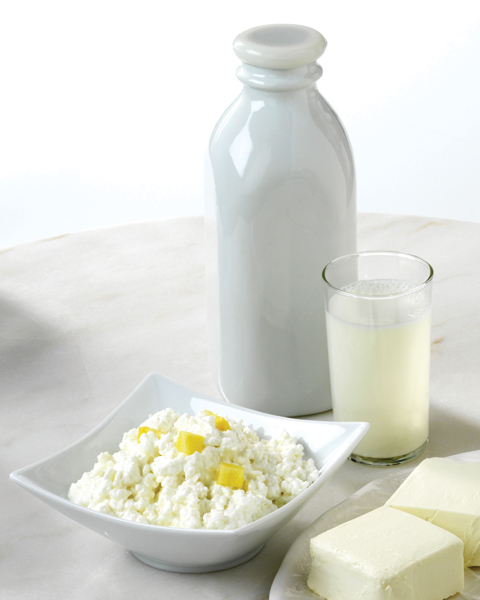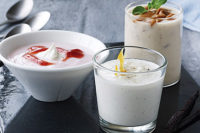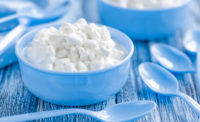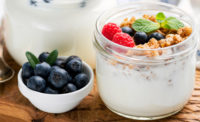
Though considered minor ingredients, with usage levels sometimes less than a percent depending on ingredient and application, acidulants, cultures and enzymes are the lifeblood of cheese, yogurt and many other dairy foods. Without these ingredients, these products would not exist.
Suppliers recognize the critical role that these functional ingredients play, and continually make efforts to improve their performance and offer opportunities to innovate.
One supplier recently introduced a specialized sour cream culture range that allows for the production of products with varying regional taste profiles. The range helps manufacturers create products aligned with local preferences, while delivering guaranteed quality and consistency for efficient production.
For example, one culture system produces the fresh lactic taste of German sour cream, while another develops the buttery, aromatic profile associated with French varieties. To help producers capitalize on the demand for American-style, reduced-fat sour creams, there is a culture system that enhances texture in products containing less than 15% fat. In regions with fluctuating milk quality, there is a culture system that enhances texture and appearance for better end-product consistency. The sour cream cultures also reduce the need for stabilizers in natural and organic options, while maintaining texture and viscosity.
This supplier also offers a range of cultures for yogurt production, which allows a yogurt manufacturer to develop a variety of tastes and textures to satisfy increasingly diverse consumer taste preferences. For example, one culture in the range produces a highly acidic, authentic yogurt flavor associated with traditional full-fat Mediterranean-style yogurts, while another allows for reduced post-acidification for a more traditional, milder flavor profile. Still another culture creates high viscosity, which results in a smooth, creamy, thick body for drinking and stirred yogurts. There is even a versatile culture system for manufacturers who want to create some variation but must limit the number of live and active cultures that enter the production facility. These culture systems contain variable strains, with some including probiotics.
Another supplier recently enlarged its range of drinking yogurt cultures to better cater to local market flavor and texture profiles. According to the supplier, what drinking yogurts have in common around the world is that they can be a quick, easy and convenient product to consume, a healthy snack and even a meal replacement, but their tastes and textures vary considerably. From salty to sweet, and thick to thin, the drinkable format of yogurt provides one of the greatest opportunities to innovate within the dairy industry.
This same supplier offers a line of protective cultures that have been selected and developed for their ability to control the growth of yeast and mold in cultured dairy products, allowing for a natural alternative to chemical preservatives. The strains function by two fundamental mechanisms. First, they form fermentation end products such as organic acids and other inhibitory compounds. Second, they compete with yeast and mold for available nutrients and oxygen… and they win.

On the enzyme side of the business, one supplier says that sales of lactase, for use in the production of lactose-free dairy foods, continue to grow as a result of more consumers claiming to be lactose intolerant and their continued desire to consume dairy foods. Lactase breaks down lactose to a mixture consisting primarily of glucose and galactose, which can be safely digested by virtually everyone, even lactose-intolerant individuals.
In addition to eliminating lactose, the resulting milk product has a naturally sweeter taste. In fact, lactase has been used traditionally in the manufacturing of ice cream. As glucose and galactose are sweeter than lactose, it enhances the taste, while also helping to ensure a smoother texture. This is because lactose usually crystallizes at low temperatures, causing sandiness in ice cream, but its constituent products, glucose and galactose, remain dissolved.
Lactase enzymes come in a variety of different product strengths, offering process flexibility. The enzyme is robust and capable of working at the pH ranges found in most milk and milk-based products such as regular fresh milk, ultra-high temperature (UHT) milk, ice cream, lassies and dulce de leche.
High-purity lactase enzymes reduce the likelihood of the milk product developing off flavors. This is of particular use in the production of UHT milk, an ever-growing industry. UHT milk is popular throughout Europe, particularly in countries with centralized dairy operations consisting of a few large units. In these situations, the milk often needs to be transported over long distances, and UHT is favored over standard pasteurized milk as it saves on distribution costs and eliminates the difficulties associated with refrigerated transportation.
Enzymes are also critical ingredients in cheese production, with some enzymes assisting with coagulation while others contribute flavor. And a new enzyme system composed of hexose oxidase can prevent unwanted cheese browning on pizza, which results when the combination of proteins, reducing sugars and acids interact in a Maillard reaction. The enzyme counteracts this process by reacting with the residual sugars (lactose, glucose and galactose) in cheese to produce non-reducing acids. In addition to oxidizing these sugars, the enzyme has also been shown to reduce mold growth in packaged cheese by acting as an oxygen scavenger.
Transglutaminase enzyme systems are also available for dairy applications. Transglutaminase has the ability to crosslink the amino acids glutamine and lysine, thereby forming covalent bonds both externally - between proteins containing these amino acids - as well as internally - within the same protein. It is this cross-linking activity that can modify the texture of dairy products.
For example, in yogurt, a patented transglutaminase preparation can improve the texture in reduced non-fat solids systems. It can also improve viscosity and perceived creaminess, and during shelf life, reduce syneresis.
In natural cheese manufacturing, transglutaminase has the potential to increase yield by capturing more protein from whey. And because of its ability to modify texture and bind amino acids, transglutaminase allows for the development of novel process cheese products, with the potential for products with enhanced melt-restriction characteristics.
Dairy foods formulators should consider acidulants, cultures and enzymes as tools to help them develop high-quality, consistent products with a sensible shelf life. They are a catalyst for innovation.
Acidulants Help Control pH
Acidulants serve a number of functions in dairy products. They provide flavor, prevent microbial growth and reduce processing time. They do this by quickly dropping the pH of the milk system. But once pH is reduced, there is no going back, so it is important to identify the best acidulant, usage level and dosing or metering method for the desired end product.
Lactic acid is the most frequently used acidulant in dairy products, since it is an inherent component of milk. Further, traditional cultures used in dairy foods produce lactic acid, thus the flavor contributed by lactic acid complements the milk base. Applications include buttermilk, dairy drinks, and cottage, mozzarella, feta and ricotta cheeses. Lactic acid is also the acidulant of choice in making sour cream, as it has a smooth acid taste that complements the sour cream flavor without the overpowering tartness of other acids.
However, other acids are useful in different dairy applications. For example, phosphoric, citric and hydrochloric acids all have application in direct-set cottage cheese. Citric acid is also used as an acidifying agent and flavor modifier in cultured milk, butter and some natural cheeses.
Glucono-delta-lactone (GDL) is a slow-release acidulant that has minimal effect on organoleptic properties. In dairy applications, GDL acts as a controlled coagulator without adding undesirable sourness. It is often used in the manufacture of direct-set cottage cheese, as well as for pre-acidifying milk for cheesemaking. GDL use results in consistent end-product quality, higher yields, faster coagulation, no post-acidification and longer shelf-life.


